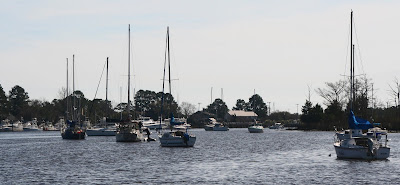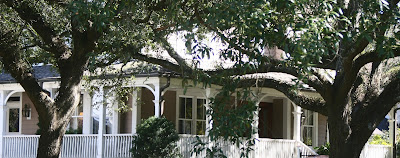View of Georgetown from the entrance to the tidal basin.
Friday, 22 February 2013. Dreary, rainy day here
along the NC-SC border – overcast, with virtually no sunshine. Temps are in the low 50’s with the potential
for severe T-Storms later in the day. Figured
it might be a good day for another blog entry, this one covering our day trip yesterday
to the historic seaport town of Georgetown, SC (population 9,000), which is about
an hour or so from us on SC’s coast.

Yesterday’s
weather was much better than today with clear blue skies and plenty of sunshine. Light jacket/sweater weather, but certainly
nice enough for getting out in the fresh air for some sightseeing in this
quaint little town with its 300-year history.
And we were most certainly not disappointed with the quiet
afternoon we spent in this charming little town that sits on the confluence of the
Great Pee Dee, Waccamaw, and Sampit Rivers; Winyah Bay; and the Atlantic Intracoastal
Waterway. Founded in 1729, few other
areas in America can boast more history or charm than Georgetown. From its earliest beginnings as a probable site of the first European
settlement in North America in 1526 – and as SC’s third oldest community – Georgetown
has long been known for its warm hospitality and Southern charm. And boy, does this place exude charm: From its
picturesque historic Front Street with one little boutique shop after another
to a variety of restaurant selections to its Live Oak lined streets (one Live
Oak is over 600-years old – and still thriving) to the many well-maintained
and/or restored historic homes (some from the early 1730’s) to the town’s tower
clock that commands one’s entire attention on Front Street’s northern edge. Georgetown's "Town Clock" sits atop a Greek revival market and town hall that was built in 1842 after a fire destroyed many of the wood frame buildings along Front Street. An open-air market occupied the first floor and the town hall the second floor.

View of the town clock, looking northeast on Front Street
Close-up view of the town clock.
To complement the whole quaint and charming atmosphere of Front Street, Georgetown’s historic
downtown area even features a grassy waterfront park and a newly renovated
Harborwalk.
Lynette under the Harborwalk sign along Georgetown's tidal base waterfront.
Another
feature of Georgetown that I found utterly fascinating as a history buff was its
rich colonial and Revolutionary War history and significance. For example, the town played an active role
during the American Revolution by sending Thomas Lynch and and his son, Thomas Lynch, Jr, to
the Continental Congress where Junior was a signer of the Declaration of
Independence. When British troops
occupied Georgetown from July 1780 to May 1781, a true American hero, Francis Marion – the infamous Swamp Fox – fought British troops in-and-around
Georgetown County in what can only be described as one of the first uses of guerilla warfare in colonial America. The status of this true American hero has been
codified by various US military and Revolutionary War historians as one of the “fathers
of modern guerilla warfare.”
As far as
our afternoon in Georgetown, we opted to kick off our visit by taking a guided
tour of the town with Swamp Fox Tours,
a local outfit that provides a 90-minute leisurely journey of the many historic
homes, churches and museums. The $15 per-person cost was well worth it as our guide provided an assortment of background
facts and historical tidbits on Georgetown, its early history, its significance
for SC and early America, as well as local color such as where’s the best place
to eat along the town’s waterfront. Following the tour -- and after taking a quick peek at the town's Harborwalk and tidal basin -- we decided to have a bite to eat before exploring more of Front Street's many shops and continuing our sightseeing adventures.

On the Harborwalk, looking east toward the mouth of the tidal basin. Restaurants -- and many businesses -- along the Harborwalk have entrances on both Front Street and from this boardwalk, many with outside seating. Nice waterfront view on a nice day, but, unfortunately, not ours.
View from the Harborwalk of the various boats anchored in the mouth of the tidal basin.
After our quick look at the waterfront and the boardwalk, Lynette let me know she was hungry and in the mood for some seafood so we opted for the River Room, located right on the town's Harborwalk.
The lunch menu had a limited selection but we both ended up with some excellent seafood fare: Lynette had the Big Fish Sandwich (it WAS huge) and a glass of German Riesling wine while I treated myself to some delicious New England-style clam chowder and a tuna sandwich. I was also delighted -- and surprised -- to find a Allagash Belgium White beer (traditional Belgium wheat style beer spiced with coriander and Curacao orange peel), on their beer menu. Bottle only, not on draught, but still brought back memories of when I first had this beer - with my son, Jamie, and his wife, Lisa - in Kill Devil Hills, on NC's Outer Banks during one of our many summer vacations. I don't often find it available in restaurants, so my choice was really quite easy. Delicious as ever!
I
took almost 70 photos during our brief visit here (thank goodness for digital cameras) – and a subsequent sidetrip to Pawley’s
Island on the way back to our campground – and have tried to include only those shots that I feel best
represent our overall impression of the whole Georgetown experience, especially among the
many photographs I took of the old colonial homes.
For those who would like to view more photos of our Georgetown daytrip,
I’ll be posting an “album” on my Facebook page over the weekend. You can check out additional photos
there. Cheers!
View of one of the many Live Oak-lined residential streets in Georgetown.
A 600-year old Live Oak -- still alive and magnificient!
Following are several of the "better" shots I took on our guided jeep tour of Georgetown's historic homes. Hopefully I've captured the architectural aspects of the early 1730's through early 1800's when many of these homes were constructed. Our guide mentioned that one family line has been living continuously in the same colonial home for 240 years. The home has been remodeled and updated, of course, but still.....
The infamous Swamp Fox, Francis Marion, once lived in this very house.
One aspect of virtually all these historic colonial homes that impressed me were the wide, spacious porches -- often on more than one level and also wrap-around. Also notice on almost every home the shutters -- must have come in quite handy during hurricane season!
The next photo is a shot of the last remaining colonial "kitchen" in Georgetown. Originally every colonial home had a kitchen, usually built off the back of the home and connected by a walkway. The cooks, usually slaves, would prepare meals and then carry them into the house. The smell of cooking bacon, sausage, and other foods would often bring stray dogs to the kitchen, and they would often bark until the cooks threw some tidbits their way to stop the barking noises. A favorite tidbit was a bit of dough rolled into a ball and then deep-fried in bacon grease. The cooks would toss the fried tidbits to the dogs and yell, "Hush, puppies." The rolled dough soon became known by the same name we know today, hush-puppies. Oh, BTW: I really didn't want the SUV in the photo, but this old colonial kitchen currently serves as a garage for its present-day occupants.

After leaving Georgetown we headed north along the coast on SC State Route 17, which took us by Pawley's Island, a famous resort town. Curious about any similarities with NC's Outer Banks region -- where we used to spend a week's vacation every year with our two sons, their wives, and our grandkids -- we took the turn that led us out to the island's residential area. Separated from the mainland by a wide salt marsh, Pawley's Island isn't quite as extensive as the Outer Banks, but nevertheless, had some fine looking homes -- many obviously of the rental variety. We drove to the southern tip of the island, which turned out to be the only public access to the shoreline on this end of the island. We got out to stretch our legs for a few minutes, did some quick beachcombing and watched the Atlantic Ocean waves pound the shore. And to answer any questions out there, "No," I did not pay the fine!
































